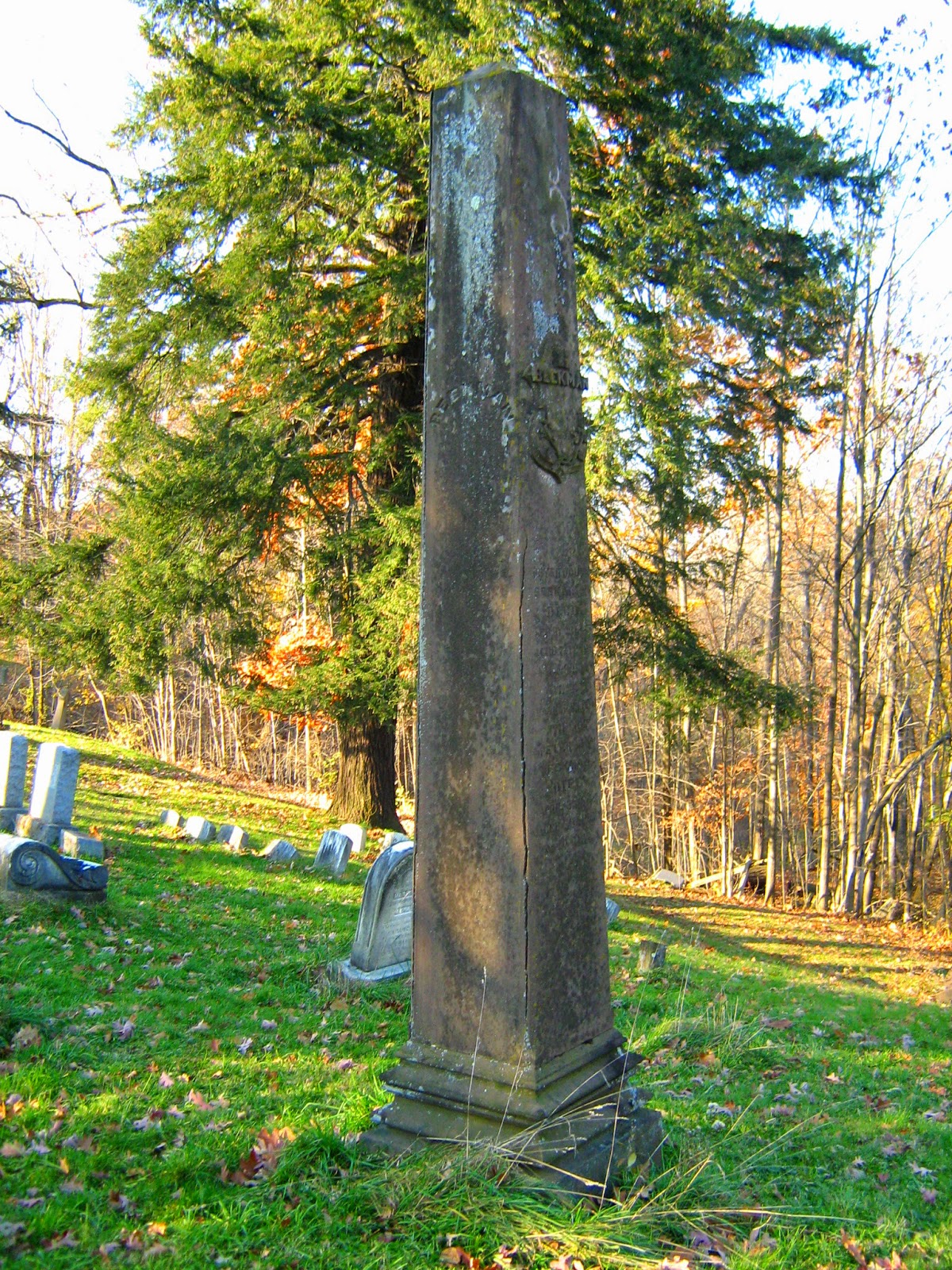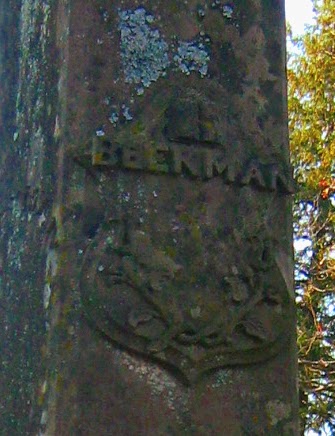There is a family plot perched somewhat precariously on the Middle Ridge hill just above the Ozia Hall monument and not too far from the Samuel Schuyler lot. From the path below, it appears to be just a row of granite urns facing a tall, but otherwise unassuming marble shaft. From the hill above, though, a set of old flat gravestones can be seen laid between the granite urns and the marble shaft.
The shaft reads simply The Family of The Souldens. One of the headstones has a very simply carved hand with its index finger pointing toward heaven. Another stone is a very pleasant discovery; a plump, winged cherub's head framed by a lozenge and flanked by daisies finials.
The lot was deeded to an Englishman named William Soulden who was interred there in 1851, just seven years after the Cemetery opened. Several of the gravestones in the lot predate the Cemetery and were likely moved here from the State Street Burying Grounds by Soulden.
Those interred in this lot include:
Sarah A. Smith, died September 7, 1825, age 88
Catherine Eliza Soulden, died February 24, 1831, age 9
William M. Soulden, died October 23, 1835, age 19
Catherine Townsend, died May 18, 1849, age 70
Ann M. Soulden, died August 9, 1849, age 32
Louisa B. Muir, died August 13, 1849, aged 32
William Soulden, died August 21, 1851, age 64
Ann M. Soulden, died November 16, 1860, age 80
The burial cards on file unfortunately provide no other details, a common occurrence with some of the older records or relocated graves.
The family had a connection to one of Albany's oldest and well-known buildings, a brick mansion built on Washington Street for Samuel Hill (who is buried in the Cemetery's Church Grounds section) and attributed to architect Philip Hooker. Documentation for the National Register of Historic Places gives some details:
"In 1820, the property was acquired by Sarah Smith, a widow, and her niece, Catherine Townsend and the Albany City Directories list Mrs. Sarah Smith as living in Hill's Mansion House on Washington Street. In 1821, William Soulden is also listed as an occupant. The Townsend-Soulden family operated the large property as a boarding house, with Aaron Burr having been among their guests in 1824. When Sarah Smith died in 1825, she bequeathed the house to Catherine Townsend and William Soulden, in trust for another neice, Ann Maria, the wife of Soulden. William and Ann Soulden owned the property until 1827."
The house in question still stands on Washington Avenue and is quite familiar to many as the Fort Orange Club.
Wednesday, February 25, 2015
Monday, February 16, 2015
The Cemetery Springs
Some recent discussions on little known mineral springs in my favorite Facebook group (Albany...the way it was) reminded me of the presence of the springs on the grounds of the Cemetery. Long forgotten, these springs are indicated on several maps of the Cemetery.
The excerpt above is from an 1871 map of the grounds that appeared in Edward Fitzgerald's Handbook For The Albany Rural Cemetery. The red markings indicate a suggested tour route for visitors and the map uses the romantic old names for the various paths, hills, and valleys (a subject for a future post or two).
Just to the right of Consecration Lake, there is a label reading Sulphur Sp.; I've made a couple of attempts to pin down the exact spot of this spring, but it appears to have been somewhere near the Cutler plot.
The same map also shows two more springs; there is a High Rock Spring just across the creek from the Townsend-Spencer lot and a Maple Spring somewhat to the southwest of President Arthur's grave.
There were, of course other springs. Fitzgerald notes that a number of springs contribute to the formation of Cypress Water, the man-made pond and fountain on the South Ridge.
Springs were also the sources for other ornamental ponds that once dotted the ground, but have long since been removed. One such pond was a small, round pool called Highland Water on the South Ridge roughly between Sections 15 and 16.
Another small pond on the North Ridge called Arbor Water. Last summer, I spotted a small, muddy sinkhole just off the paved road. At one edge of the eighteen-inch hole, there was a steady flow of very clear water which may have been from such a spring and may have once been the source for Arbor Water.
On the South Ridge , there is also Cold Spring Dell, a narrow little gully with a stream flowing through it from a source near the fence separating Albany Rural and St. Agnes Cemeteries. This stream flows into the above-mentioned Cypress Water.
Thursday, February 12, 2015
The Soldiers Monument
In honor of Lincoln's birthday and Throwback Thursday, a view of the Civil War monument that faces the Soldiers Lot on the North Ridge. The photo, taken around 1900, shows the granite plinth surrounded by urns of foliage, and iron markers such as the Grand Army of the Republic. The plaques on the monument were cast from captured Confederates by Congressman (and former Albany mayor) Eli Perry.
The front of the monument features an oval bronze medallion of President Lincoln. The laurel wreath surrounding the President's likeness is visible in this photo, but was unfortunately stolen in the 1990s. The medallion itself is signed "Pickett 1873" and seems to have an interesting history.
The front of the monument features an oval bronze medallion of President Lincoln. The laurel wreath surrounding the President's likeness is visible in this photo, but was unfortunately stolen in the 1990s. The medallion itself is signed "Pickett 1873" and seems to have an interesting history.
Monday, February 9, 2015
Section 50
The little green and white metal section markers are a familiar sight to anyone who has walked or driven through the Albany Rural Cemetery. But it's not too often that one sees the older stone section markers like this one near the western end of the Middle Ridge.
Saturday, February 7, 2015
Rachel Groesbeck Van Santvoord
While transcribing some Dutch Reformed burial ground inscriptions from one of Joel Munsell's many and always useful volumes of Albany history, one particular inscription stood out from the long list.
In memory of Rachel Groesbeck, Wife of Anthony Van Santvoord, who departed this life in the middle Dutch church, the 8th
day of March, 1835, aged 60 years, 2 months and 3 days.
While
seated in the house of God To worship him she loved, He called her
from his house below, To worship him above.
It's the first time I've encountered the epitaph of someone who passed away during church services and I was certain that, while I didn't recall seeing that part of the epitaph, I had indeed seen the name on headstone and photographed it. It took a bit of searching, but I finally located the photo in a folder full of iron fences, toppled tombstones, fallen trees, and other odds and ends from the Cemetery's North Ridge.
It's an old marble slab-style headstone now flat and embedded in the ground on the same high hill as David Strain, the Lockwood family and the Lochner monument with its pretty urns. Between the usual darkening of the stone and the overlapping turf, it was easy to miss the complete inscription at the time the photo was taken.
The daughter of Anthony Groesbeck and Cathalyntje De Forest, Rachel was born on January 5, 1775. She married Anthony Van Santvoord (also spelled Santvoort) in 1806. She was his second wife; his first wife, Maria Roff, had died in 1800 at the age of thirty-four.
Anthony Van Santvoord, who resided on Market Street (now Broadway), was a merchant and, like Captain Bogart, one of the last of Albany's Hudson River skippers. He died in 1852 at the age of ninety. After his death, he was extensively profiled in Munsell's Annals of Albany.
Friday, February 6, 2015
Peter Douw Beekman
A sandstone shaft on the Middle Ridge just down the road from the Delavan family lot marks the grave of Peter Douw Beekman. A veteran of the Revolutionary War who later served as a justice of the peace, Beekman was born in 1762 and married Hannah Hilton. The couple lived in Albany on Van Schaick Street, a short street that ran between Fox Street (now Sheridan Avenue) and Orange Street. The home overlooked the Vozenkill, also known as Fox Creek and now buried under Sheridan Avenue.
When he died in 1835, he was buried in the Dutch Reformed section of the State Street Burying Grounds where several of his children who had predeceased him were already laid to rest (including two unmarried daughters Phebe who died in 1819 at the age of 20 and Elizabeth who died in 1823 at the age of 32). These graves were removed from the Burying Grounds to Albany Rural Cemetery well in advance of the general disinterment in the late 1860s, probably after the death of his widow, Hannah, in 1849. This family's burials don't appear in the Cemetery's index card files, a common case with these older reinterments.
The sandstone shaft may be the original monument brought over from the burial grounds. The front of the shaft has a carved shield with the family name. Above the name is an open book, probably representing the Bible or symbolic of wisdom. Below it is a garland of woody stems ending with tulip-like buds.
Gertrude Justine Norman
This lovely, but unfortunately toppled headstone on the North Ridge (not far from the Soldiers Lot and Hallenbeck family plot) has an elegant Gothic style and beautiful lettering. The crosses flanking the surname are rather interesting; the one on the right is simply a series of dots. Was it meant to be this way or were the dots a guide for the carver who left it unfinished?
The stone marks the grave of the infant daughter of Albany architect Thomas E. Norman whose work included the First Lutheran Church (at the time located at Pine and Lodge Streets). Perhaps he also designed the stone for his child's grave. He died in 1873 and is also buried in this family lot.
Subscribe to:
Comments (Atom)









